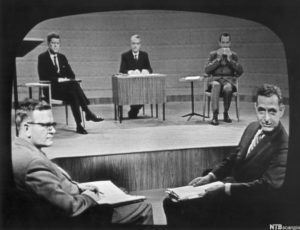This is going to start like a political think piece, but I swear it’s about math curriculum and pedagogy.
Next to ‘THE TELEVISION’ in my high school textbook is a picture of Kennedy and Nixon having the first televised debate. At this debate Nixon showed up sort of

prepared, looking hot and sweaty, and perhaps a little rattled by the appearance of his opponent. As my teacher told the story, JFK spent weeks prior at Martha’s Vineyard relaxing and preparing for the debate. He showed up looking relaxed, tanned and screen-ready. He even had a makeup crew! JFK was prepared for the new medium of television and because of that he won the debate, and a lot of popular opinion. His control of that medium, led to control of the white house and the establishment of presidential debates as a critical part of any campaign.
If my daughter grows up to be a history teacher, she will probably have a section to teach about ‘THE RISE OF SOCIAL MEDIA’ they will probably have one of Trump’s tweets. Trump is the figure here, because he is probably the first person to really master that medium, and hopefully no one will ever manipulate the public in that way again. Trump shoots off tweets faster than the fact checkers could keep with him, which I’m sure his followers loved. At the same time, Facebook, Twitter, YouTube and other platforms were directing people to more and more content using machine learning algorithms. Delivering people things what they want from the universe of content on their platforms helped these companies sell more ads. As shown in the Social Dilemma, the technology can push people down rabbit holes, some of which can be dangerous and toxic. As the new technology helped people find more and more about his message, aided by targeted campaigns from Russian and Cambridge analytica, Trump shocked the world with his 2016 win. The rabbit holes kept burrowing deeper conspiracies like Pizzagate and QAnon continue to snare Trump supporters.
Today after math class a group of students started listing a group of conspiracies they heard online, too many for the teacher to counter. It sounded as though the students were delivering outrageous claim after outrageous claim, but could only back it up by saying “I saw it online”. These teenagers had been pushed down the same rabbit holes that are leading to much of the political extremism of our now polarized country. When faced with an actual argument, an actual opposing view, it sounded like the students faltered. Perhaps this is where math class comes in.
If we do it right, math class could address the problem of students we are losing to social media. In math class we talk about communication, argumentation, and proof from Pre-K to PhD with an emphasis on applying it in new situations with fluency. Often schools skip this work and focus on computation, but that is dangerous. Students deep into social media get fed post-after-post of things they agree with, where they may stop expecting ideas to proved with logical arguments. If we want schools to teach students to logically pick apart an argument, ask questions, write out proofs and to do it all with speed and fluency, then math is subject to teach it. Math class is be the place where students build the muscles to apply, analyze, and support what they learn in History, Science and other classes or at least it could be.


Leave a Reply